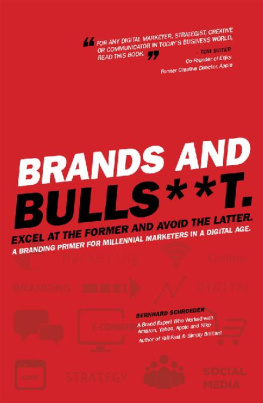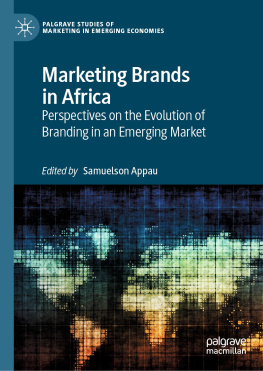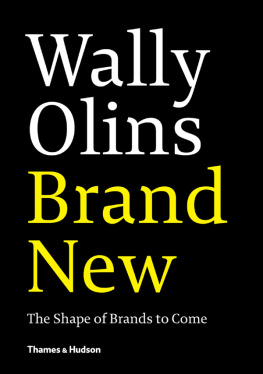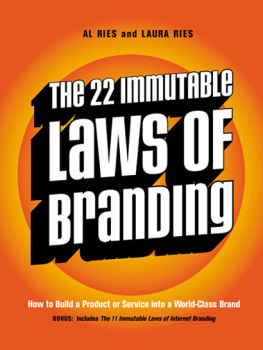
To Dornie

Contents
What is going to happen to brands and branding? Is it all over? Does globalization mean that variety and individuality will be crushed out of existence by massive multinational corporations who will dominate world markets with their immense promotional power? Does it mean that, wherever we live, we will all end up buying and using versions of the same stuff? Will everywhere in the world become increasingly similar, like airports today?
If, on the other hand, globalization is taking over and the world is becoming increasingly homogenous, how is it that nation, region and city branding have become so important? Why is every place shouting so loudly that it is the most attractive spot in the world to invest in and to visit, and that the brands it produces are the worlds most desirable? If everything and everywhere is becoming increasingly similar, will there still be room for places that trade on being different?
Or is something completely different happening? Does the rise of digital technology mean that corporations will increasingly be on the defensive because customers will not only answer back but will ask a few questions and make a few demands on their own initiative? Does digital mean that everyone who feels like it will be able to make their own brand and market it like self-publishing? And, if it does, where does that leave the multinational corporation?
What do we customers want anyway? Do we want it cheap? Do we want it authentic? Do we want it, whatever it is, to come from somewhere place branding again? Do we want it all at the same time? Or do we just keep changing our minds on alternate Thursdays?
What about sustainability, going green, global warming, the environment, and so on? How do they affect the way we think about the products and services we consume? And how do they influence the way we feel about the organizations that make and sell those products and services? Do we really believe that oil companies want to save the world? Is corporate social responsibility (CSR) as significant as everybody now says, or is it just a shibboleth or even a passing fad? And how can companies reconcile maximizing profitability with CSR?
Put another way, what is the corporation there for? To make profit and grow, or to help society, or both? And how can the corporation demonstrate that it cares if it cares? And what if it operates through a multiplicity of brands? Does this mean that the corporation has to stand up and be counted; that it has to be seen to be the face behind all its brands? What about charities and NGOs? Are they going to become more professional and brand themselves?
Then there is the changing shape of world power; the relative decline of the West in the face of the growing political and economic power of emerging markets. Or do we mean already emerged markets? Will these countries start producing and promoting global brands based around their own cultural strengths and heritage? And, if they do, what will this mean for the traditional global dominance of brands based around Western cultural norms? Will they die, or will there just be more competition?
And then, assuming for the moment that brands dont die and that there will always be plenty of them around, whos going to build and sustain them? And what will happen to the brand consultancy business? Will it increasingly rely on metrics, quantification and scientific research? What about flair and intuition in the creation and sustainability of brands? Will this disappear and be replaced by bland work created entirely out of rigorous analysis? Put another way, will there be yet another face-off between rational and emotional; rigour and intuition; head and heart?
All these, and a few other issues, too, face the branding activity over the next decades. I am writing about it all now, because I wont be here to see it and listen to people telling me how wrong I was.
Wally Olins, Goring-on-Thames, 2013

I am getting a bit bored of reading about whether the Mini is still authentically British. The Mini is built in Oxford, the Rolls-Royce is put together at Goodwood; both are owned by BMW and, if you look carefully, it shows. But, of course, both want to say they are British. Maybe they are, but they certainly have a strong German accent. Bentley, assembled at Crewe and owned by VW, isnt that British either. Its full of the same parts as VWs prestige car, the Phaeton. Is Jaguar Land Rover, owned by Tata, still British? The point about all these cars is that they try, and they sort of seem, to be British. They certainly emphasize heritage.
What about the Peugeot 107 and Citron C1? Are they French? Is the Toyota Aygo Japanese? They are all more or less the same car underneath, and they are all built in the Czech Republic in the same factory.
Some true blue British cars made by Aston Martin a company, incidentally, owned by a Kuwaiti consortium and run by a German are built in Austria. Nobody talks about that. Slovakia makes more cars per head than any other country in the world, but nobody talks about that either.
In an era in which transnational companies are making everything everywhere, at a point in time when nobody really knows where most things come from, we, as consumers, still love to think that the things we treasure come from somewhere a particular place. We like to feel that provenance is a guarantor of quality; that it confirms our preconceptions about German technology, or Spanish passion, or Italian style, or French flair, or perhaps more especially food from local ingredients and often it does. So perhaps, because almost everything we touch comes from all over the globe, paradoxically this increases our yearning for authenticity and provenance.
Just behind where I live in Englands Thames Valley is a farm which, in a very short season, grows asparagus. As soon as the season begins, we rush over and pick as much as we can and we have lots of friends over to eat it. Then we casually say, Do you like the asparagus? We picked it yesterday in the field just over there. Yes, its real Oxfordshire asparagus. Of course, they all love it. Its the authenticity that gets them. Its local and its fresh and we picked it with our own hands. And everyone feels good about it, because it didnt burn up carbon to get here and its sustainable and environmentally friendly and all the other good things you can think of.
So, where we can, we continually emphasize provenance. Our supermarkets and specialist food shops are full of products whose provenance is its main differentiator: fruit, cheese, beef, lamb, pork, poultry, soap, cosmetics, everything Grown in, or made using ingredients grown in.
Then there are the farmers markets, bringing fruit, vegetables, fish and meat straight from the countryside to the urban customer. Of course, you expect these in small country towns or even in some cities, but they are absolutely everywhere, every week. Theres a farmers market every Sunday just off smart, chic, bustling, trendy Marylebone High Street in central London, just a few blocks away from Selfridges department store and its genuine. Then theres another, Borough Market, practically opposite the Tower of London. Borough Market is so famous not just for its fresh food, but also for its cafs, pop-up restaurants and the rest of the foodie mix that its now a significant tourist attraction.
Next page









